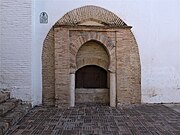| Church of San Miguel Bajo | |
|---|---|
| Iglesia de San Miguel Bajo | |
 Church exterior, with entrance portal and bell tower Church exterior, with entrance portal and bell tower | |
| Religion | |
| Affiliation | Catholic |
| Location | |
| Location | Albaicín, Granada, Spain |
 | |
| Geographic coordinates | 37°10′54″N 3°35′43″W / 37.181656°N 3.595314°W / 37.181656; -3.595314 |
| Architecture | |
| Type | Church |
| Style | Mudéjar, Renaissance |
| Date established | 1501 |
| Groundbreaking | 1528 |
| Completed | 1577 |
The Church of San Miguel Bajo (Spanish: Iglesia de La Aurora y San Miguel Bajo) is a church and historic monument in Granada, Spain. The church is located in the historic Albaicín neighbourhood, at Placeta de San Miguel Bajo. It was built in the 16th century on the site of the neighbourhood's former main mosque and incorporates an element of its remains.
History
The area of Placeta de San Miguel Bajo formed the site of the al-Qaṣaba al-Qadīma palace complex of the Zirid emir Badis. The complex, which was later displaced by the Alhambra under the Nasrid dynasty, comprised a number of buildings, of which the Dar al-Horra palace is the most complete remaining example. These included a mosque on the site of the present church. The mosque's original cistern, dating from the 13th century remains, embedded in the façade of the church facing the square. Other elements of the cistern are even older, Roman columns have been reused as carrying shafts.
After the conquest of Granada in 1492 by the Catholic Monarchs of Spain the building continued as a mosque, serving the Mudéjar population of the city. It became a parish church in 1501 after the forced conversions that followed the Rebellion of the Alpujarras and the creation of 23 new parishes, under the direction of Cardinal Francisco Jiménez de Cisneros, archbishop of Toledo and primate of Spain. In the following 20 years, the mosque was completely destroyed, with the exception of the cistern, and replaced by a Catholic church, with building taking place in two stages between 1528 and 1577.
The church closed in 1842 due to falling congregations, and many of its interior fittings were removed. It reopened in the 21st century as the headquarters of the brotherhood, La Aurora - Penitencia del Albayzín. The baroque Cross of Christ which stands in the square was originally located adjacent to the church, but was relocated to the opposite side of the square following the Spanish Civil War. The church holds a Sunday mass and is open to the public for limited hours on Fridays, Saturdays and Sundays. The tower gives views of the city.
Architecture
The church is constructed of brick and stone, faced in white plaster. The bell tower echoes the minaret of the original mosque. The entrance façades have been attributed to Diego Siloe (c. 1495–1563), creator of the Granadan school of sculpture. There are two doorways, both with elaborate doorcases; the one facing the square has Corninthian pilasters, while that facing the entrance street is more Renaissance in style.
The church has a single nave, about 40 metres long and 20 meters wide, and the two stages of development are visible. The first section, completed 1528-1539 is Mudéjar in style, and attributed by Agencia Albaicín to a builder, Antonio Fernández, and a carpenter Gil Martín. It is notable for its wooden ceilings. A second building period took place between 1551 and 1557. This follows a more Renaissance style associated with the contemporary El Escorial.
Gallery
Footnotes
- The name distinguishes the area, and the church, from San Miguel Alto, located on a hill at the northern end of the Albaicín.
- The Dar al-Horra was the home of Aixa, mother of Muhammad XII the last Nasrid ruler in Spain.
- Siloe came to Granada in 1528, and remained in the city until his death working on Granada Cathedral and the Monastery of St Jerome.
References
- "Aljibe del Rey" (in Spanish). Rincones de Granada. 7 December 2017. Retrieved 15 June 2024.
- "El Aljibe del Rey, el pozo de la Alcazaba" (in Spanish). Granada Hoy. 27 November 2009. Retrieved 15 June 2024.
- Chisholm, Hugh, ed. (1911). "Boabdil" . Encyclopædia Britannica. Vol. 4 (11th ed.). Cambridge University Press. p. 94.
- ^ "Iglesia de San Miguel Bajo" (in Spanish). Agencia Albaicín. 7 June 2021. Retrieved 15 June 2024.
- ^ "Church of La Aurora and San Miguel Bajo". turismo.granada.org (in Spanish). Ayuntamiento de Granada. Retrieved 15 June 2024.
- "Iglesia del Salvador" (in Spanish). Agencia Albaicín. 7 June 2021. Retrieved 16 June 2024.
- "Historia" (in Spanish). Perdon Aurora. Retrieved 15 June 2024.
- ^ "Diego de Siloé". Encyclopaedia Britannica. Retrieved 15 June 2024.
| Historical monuments of Granada | |
|---|---|
| Alhambra | |
| Albaicín | |
| City centre | |
| other districts | |



